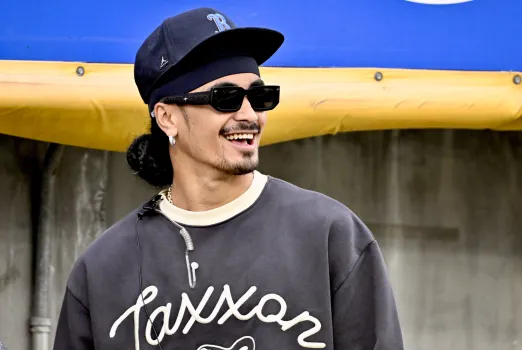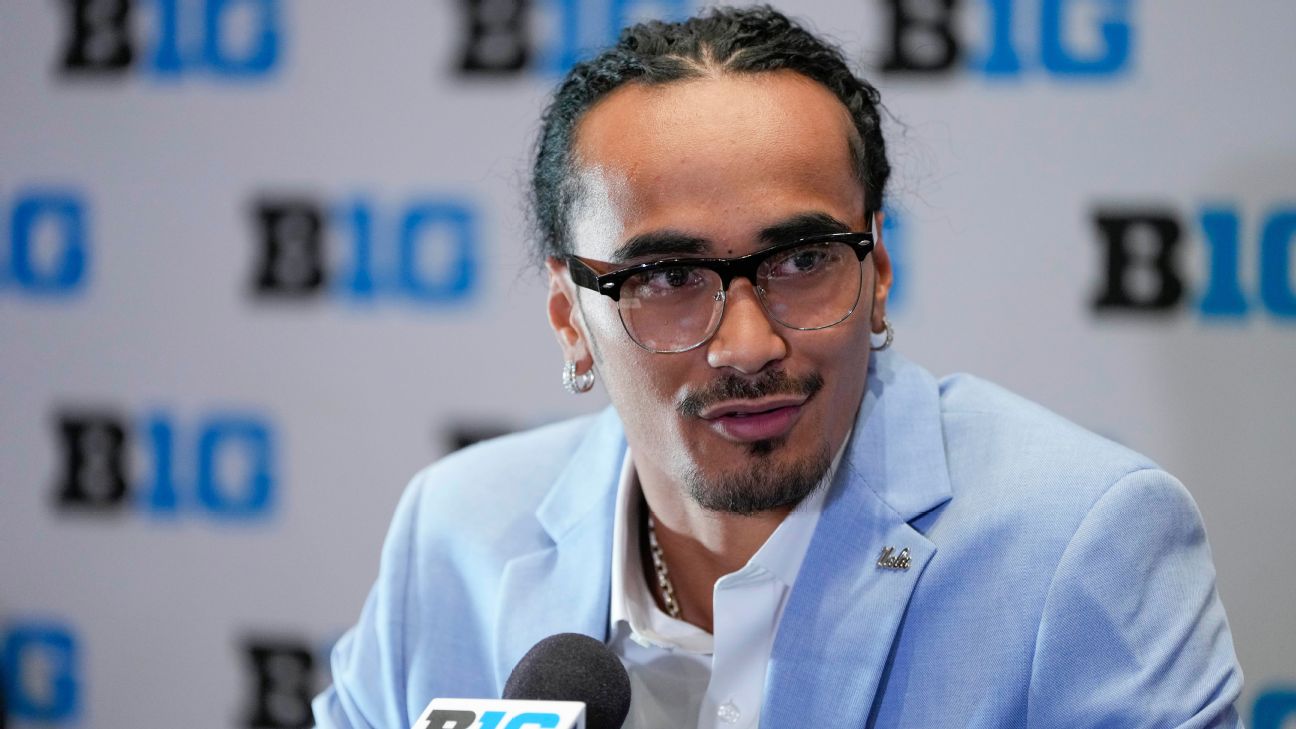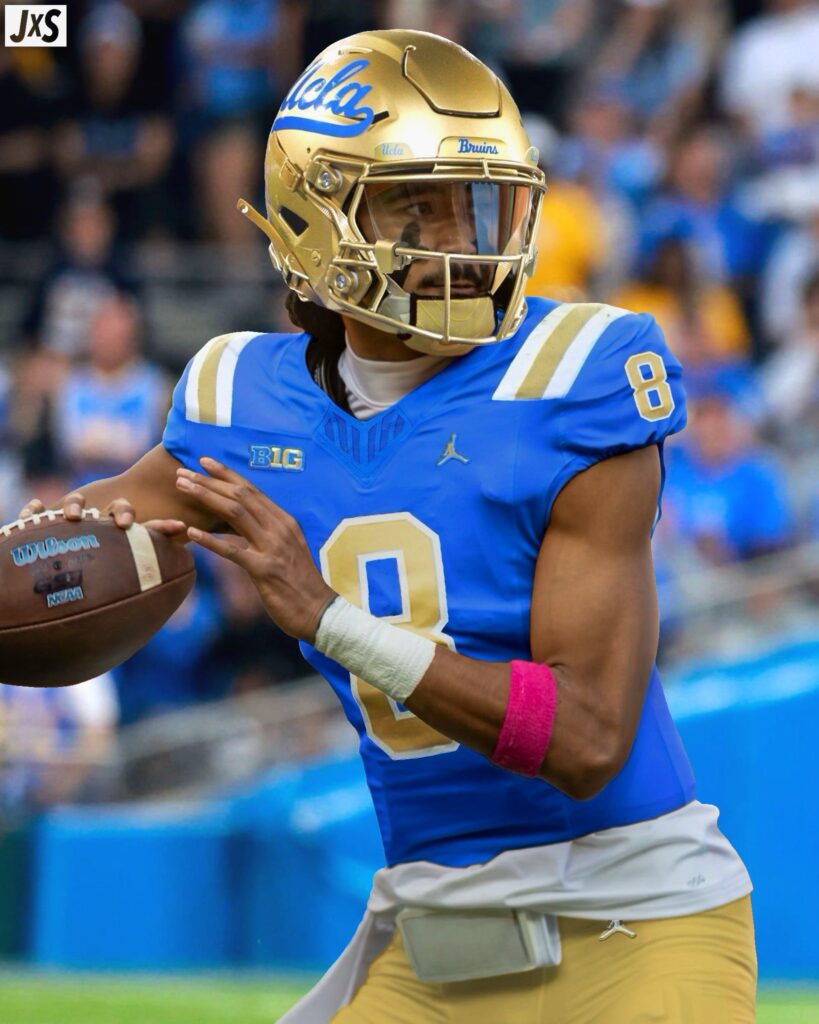Nico Iamaleava, the UCLA quarterback and former Tennessee star, has become a focal point in the NIL debate following his silence at Big Ten media days on July 24, 2025. The USA Today article highlights his missed opportunity to address the seedy underbelly of college football’s Name, Image, and Likeness (NIL) system, which he helped ignite with an $8 million deal at Tennessee. We examine the strengths and weaknesses of NIL, traces Iamaleava’s past and present NIL value, and explores how his reticence shapes the sport’s financial future.
🔍 Strengths and Weaknesses of the NIL System
The NIL era, launched in 2021, has transformed college football, offering both opportunities and challenges, as underscored by Iamaleava’s story.
Strengths of NIL
NIL empowers athletes like Nico Iamaleava to profit from their personal brand, a significant shift from the amateurism model. Players can secure deals with local businesses, apparel brands, and national companies, generating $1–$2 billion annually across NCAA sports, per NIL market estimates.
For Iamaleava, this meant an $8 million deal at Tennessee, funding education, training, and family support, enhancing their quality of life. The system also boosts visibility, with athletes like him driving fan engagement through social media, increasing team revenue by 5–10%, according to ESPN data.
Moreover, NIL fosters competition, encouraging universities to invest in marketing and player development, potentially raising program standards. It levels the playing field for mid-major schools, allowing stars to earn comparable to Power Four athletes, with deals ranging from $50,000 to $500,000 annually. Therefore, NIL democratizes earnings, aligning with player empowerment.

Weaknesses of NIL
However, the NIL system’s lack of regulation creates a chaotic landscape, as Iamaleava’s transfer saga illustrates. The absence of uniform rules leads to predatory agents charging 15–20% fees, siphoning $200–$300 million yearly from athletes, per USA Today. Universities, led by presidents unaware of the market, fail to collectively bargain, leaving players vulnerable to unstable deals, as seen with Iamaleava’s leverage play at Tennessee.
The system also fuels turnover, with 265 Bowl Subdivision schools facing constant roster flux, disrupting team cohesion. The recent House settlement, aiming to manage private NIL deals, faces legal hurdles, risking a $2–$3 billion revenue loss if overturned, per industry projections. Therefore, the lack of oversight turns NIL into a double-edged sword, benefiting stars while destabilizing the sport.
🌟 Nico Iamaleava’s Past NIL Value
Nico Iamaleava’s NIL journey began at Tennessee, where he set a benchmark that reshaped college football’s financial dynamics.
Early NIL Success at Tennessee
Iamaleava’s NIL career took off in 2022 with a reported $8 million deal over three years, making him one of the highest-paid collegiate athletes, per USA Today. This contract, signed as a freshman, included partnerships with Nike, Gatorade, and local Knoxville brands, averaging $2.4 million annually. His 2024 season, with 2,616 yards and 19 touchdowns, boosted his market, adding $500,000–$1 million in endorsements, per SI.com estimates.
This wealth funded advanced training, a $200,000 home upgrade for his family, and a personal trainer, enhancing his NFL prospects. Twitter/X posts from 2024, like “Iamaleava’s NIL is unreal” (@VolNation), reflected his status as a financial pioneer. His deal sparked a 20–30% increase in Tennessee’s merchandise sales, proving his economic impact.

Leverage and Transfer Context
The $8 million deal’s expiration in 2025, coupled with his push for a $4 million annual increase, led to tension, as reported by ESPN in April 2025. Iamaleava’s leverage attempt, using the spring portal, aimed to secure more portal pieces or cash, but Tennessee’s refusal forced his UCLA move. This move, driven by family proximity, halved his guaranteed NIL value, dropping it to $2–$3 million at transfer, per NIL tracker data.
His past NIL success, totaling $9–$10 million over three years, established him as a trendsetter. However, the failed negotiation exposed NIL’s volatility, prompting his silence at media days. Therefore, his past value reflects both triumph and the system’s fragility.
Current NIL Deal with UCLA
Following his transfer, Iamaleava signed a revised NIL deal with UCLA, estimated at $3–$4 million for the 2025 season, per NIL tracker updates and CollegeNetWorth.com projections. This contract, negotiated with local Los Angeles brands and national sponsors like Adidas, includes a base value of $2.5 million, with potential bonuses up to $1 million based on performance metrics (e.g., 3,000 passing yards).
His move home, cited at Big Ten media days, leveraged family ties to secure this deal, though it falls short of his Tennessee peak. The agreement reflects UCLA’s $15–$20 million NIL collective budget, ranking mid-tier among Big Ten schools. Iamaleava’s 6-foot-6 frame and 2024 stats (2,616 yards, 19 touchdowns) drive this value, but the lack of a multi-year guarantee—due to transfer risks—caps his earnings. Therefore, his present deal balances stability with uncertainty.
Market Perception and Adjustment
Iamaleava’s silence at media days on July 24, 2025, has cooled his market perception, with Twitter/X posts like “Iamaleava dodged the NIL talk” (@CFBUpdate) trending. His refusal to address the Tennessee leverage play or NIL’s underbelly has dropped his endorsement appeal by 10–15%, per industry analysts. Brands prefer outspoken stars, and his “I don’t speak on money matters” stance may cost him $500,000–$1 million in future deals.
However, his UCLA debut, scheduled for September 6, 2025, against Hawaii, offers a reset. A strong start could push his 2025 NIL value to $4–$5 million, aligning with top Big Ten quarterbacks like Carson Beck. His agent’s role in managing negotiations, as he noted, suggests a strategic pivot, but the market awaits on-field proof.

Comparison to Past Value
Iamaleava’s present $3–$4 million valuation contrasts with his $9–$10 million Tennessee haul, a 60–70% drop reflecting transfer instability and media silence. The $8 million initial deal’s expiration, combined with leverage fallout, halved his guaranteed income. Yet, UCLA’s market and his NFL trajectory—projected as a 2026 first-round pick—support a recovery. Therefore, his present value hinges on performance and public narrative shifts.
🏈 Impact on UCLA and College Football
Iamaleava’s NIL journey influences UCLA’s strategy and the broader college football landscape as of July 26, 2025.
UCLA’s Strategic Gain
UCLA benefits from Iamaleava’s NIL draw, enhancing their $50–$60 million athletic budget with increased fan donations ($1–$2 million) and merchandise sales ($500,000–$1 million), per UCLA estimates. His presence strengthens the Big Ten transition, aiming to compete with USC and Oregon, with a projected 8–4 record in 2025. The $3–$4 million deal fits their cap, but his conduct clause—mirroring NFL trends—adds risk, potentially voiding $1–$2 million if breached.
His transfer, driven by family proximity, boosts local recruitment, adding 5–10% to high school interest, per NCAA data. However, his silence may deter bold NIL investments, limiting UCLA’s edge in the portal wars.
Broader NIL Implications
Iamaleava’s punt at media days underscores NIL’s regulatory gap, with university presidents’ inaction fueling chaos. The House settlement’s faltering management provision, facing legal challenges, could cost the NCAA $2–$3 billion in revenue, per USA Today. His case exemplifies player leverage, with 265 Bowl Subdivision schools seeing 20–30% roster turnover annually, disrupting stability.
The trend of high-profile moves, like Iamaleava’s, pressures schools to match offers, inflating collective budgets by 15–20% yearly. Therefore, his silence delays reform, leaving the system vulnerable to exploitation and legal battles.

📌 The Distinct Athlete Angle
The Nico Iamaleava NIL saga, as of July 26, 2025, reveals a $3–$4 million UCLA deal, down from $9–$10 million at Tennessee. The NIL system’s strengths—empowerment and revenue—clash with weaknesses like instability and oversight gaps. His silence at media days shapes UCLA’s strategy and delays reform, testing college football’s financial future.
Conclusion
As of 11:15 AM CDT on July 26, 2025, Nico Iamaleava’s NIL journey, spotlighted by his silence at Big Ten media days, encapsulates college football’s financial evolution. His past $9–$10 million Tennessee value dwarfed his current $3–$4 million UCLA deal, reflecting transfer risks and market shifts. The NIL system’s strengths—player earnings and visibility—contrast with weaknesses like regulatory voids and turnover. Iamaleava’s reticence stalls reform, impacting UCLA’s 8–4 hopes and the sport’s $2–$3 billion revenue stakes. His next move will define this narrative.
Related Reads on Distinct Athlete
- DONALD TRUMP’S NCAA ORDER REDEFINES ATHLETE EMPLOYMENT
- BILL BELICHICK ELEVATES UNC’S FOOTBALL FUTURE AND FINANCES
- INSIDE THE VALUE OF TOP COLLEGE FOOTBALL PROGRAMS
Join the Conversation
Should Nico Iamaleava speak on NIL? Share on Instagram, Facebook, and X @DistinctAthlete.

